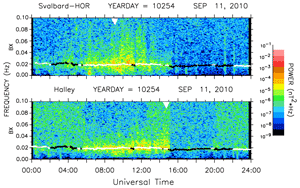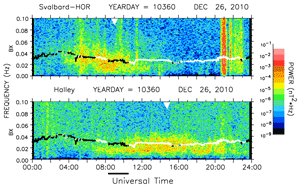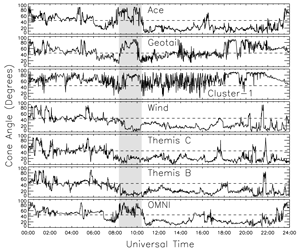
2014 THEMIS SCIENCE NUGGETS
Investigating the IMF Cone Angle Control of Pc3-4 Pulsations Observed on the Ground
by Dr. Mark Engebretson, Augsburg College, Minneapolis, MN
Introduction
Magnetic pulsations, which are small, long-period oscillations in Earth's magnetic field, were first observed over a century ago at various locations on Earth. Satellite observations have revealed that they are generated as plasma waves in the upper reaches of Earth's space environment, in a region called the magnetosphere because it is defined by the extension into space of the Earth's magnetic field.
One particular class of these pulsations (called Pc3-4, with periods of 15 to 40 seconds) is now understood to be generated in the solar wind, just upstream from the boundary where the solar wind impinges on Earth's magnetosphere, and is often observed on the ground during daytime hours. Direct observations by spacecraft in this upstream "ion foreshock" region showed that the center frequency of these waves is proportional to the strength of the interplanetary magnetic field (IMF), and that they can propagate to Earth when the IMF is aligned within 45° of the line connecting the Sun to the Earth.
Because the solar wind and IMF exert such significant influences on magnetospheric dynamics, continuous upstream monitoring has become an important part of current international efforts for both scientific purposes and space weather monitoring. However, our knowledge of ion foreshock conditions and of the IMF orientation is often incomplete, because of the very limited number of spacecraft providing upstream data. The constraints of orbital dynamics dictate that providing near-continuous observations just beyond the front of Earth's magnetosphere would require a large number of spacecraft. Spacecraft near the L1 libration point, a gravitational "sweet spot" 230 Earth radii upstream from Earth, can remain there indefinitely and can provide essential early warnings of solar wind and IMF structures that might reach Earth's magnetosphere roughly 1 hour later. NASA scientists have used the available spacecraft data from the L1 point to construct the OMNI database of detailed solar wind and IMF data that would be expected to impinge on Earth's magnetosphere. However, this large distance has prompted questions about the effectiveness of such a monitor for characterizing the plasma that subsequently impacts Earth's magnetosphere.
Results
In this study we compared 13 months of magnetic observations at two widely separated ground stations (Hornsund, Svalbard, Arctic Norway and Halley, Antarctica) to OMNI IMF values, in order to test the relationship between Pc3-4 wave occurrence and the IMF. Values of the IMF cone angle (between the IMF and the Sun-Earth line) and the empirically predicted wave frequency (fpred=0.06 BIMF) were compared to daily Fourier spectrograms displaying pulsation power and frequency, as in Figure 1.
| Figure 1. Full-day Fourier spectrograms of the north-south (X) component of induction magnetometer data from (top) Hornsund, Svalbard and (bottom) Halley for September 11, 2010. The vertical scale shows wave frequency in Hertz, and the horizontal scale shows universal time in hours. The nearly horizontal line shows the calculated Pc3-4 center frequency and color-coded IMF cone angle, based on OMNI data. White, grey, and black represent angles between the IMF and the sun-Earth line from 0° to 40° or 140° to 180°, from 40° to 50° or 130° to 140°, and between 50° and 130°, respectively. The white triangles at the top of each spectrogram indicate the time of local magnetic noon. The yellow color between 05:30 and 15:00 UT at both sites indicates strong, sustained wave power. It is simultaneous with the time interval during dayside hours when the cone angle was below 40° (white line). |
Although there was often good temporal agreement between low cone angles and increased Pc3-4 wave power, as in Figure 1, we also found numerous examples of disagreement, as in Figure 2.
| Figure 2. Full-day spectrograms of induction magnetometer data from (top) Hornsund, Svalbard and (bottom) Halley for December 26, 2010. The yellow color from 03:30 to 13:00 UT at Hornsund and from 07:00 to 21:00 at Halley (across local noon at each station) indicates strong, sustained wave power. However, the IMF cone angle was well over 50° from 08:20 to 10:25 UT. |
In order to gain further understanding of such cases, we looked at a number of days when several spacecraft were positioned upstream of Earth's magnetosphere. In contrast to September 11, 2010, when all available spacecraft observed the same cone angles, in agreement with ground observations of Pc3-4 waves, Figure 3 shows upstream data for December 26, 2010, when different upstream spacecraft observed different angles.
| Figure 3. Cone angle plots created using time-shifted IMF data from all available spacecraft upstream of Earth's bow shock and from OMNI, for December 26, 2010. The upper three panels show data from spacecraft offset dawnward from the Sun-Earth line, and the next three panels show data from spacecraft offset duskward. The grey shading between 08:20 and 10:25 UT indicates that Wind, Themis C, and Themis B observed low cone angles, consistent with the ground-based observations. |
In general, when Earth-orbiting spacecraft such as Themis, Geotail, and Cluster were located in the near-upstream solar wind, these provided data more consistent than OMNI with Pc3-4 wave observations.
A statistical study of all Pc3-4 wave activity at Hornsund and Halley from June 2010 to June 2011, in quarter hour increments, showed that the OMNI database correctly predicted the occurrence of Pc3-4 pulsations 81% of the time at Hornsund, and 83% at Halley. Earlier studies of IMF structure have shown that individual IMF flux tubes have a transverse scale size of ~70 Earth radii as well as a slightly curved shape; both effects are consistent with these percentages.
Conclusion
This study provides a quantitative estimate (~80%) of the accuracy of the OMNI data set in characterizing conditions near the nose of Earth's bow shock under predominantly radial IMF conditions. Despite the value of upstream monitors at the L1 libration point for providing advance warning of solar wind structures approaching Earth, their accuracy may be especially limited in such cases. OMNI and time-shifted L1 data should be used with some caution when attempting to characterize conditions in the ion foreshock, and whenever multiple spacecraft are positioned in the solar wind, data from those closest to Earth should be given priority.
Reference
Bier, E. A., N. Owusu, M. J. Engebretson, J. L. Posch, M. R. Lessard, and V. A. Pilipenko (2014), Investigating the IMF cone angle control of Pc3-4 pulsations observed on the ground, J. Geophys. Res. Space Physics, 119, doi:10.1002/2013JA019637.Biographical Note
Elianna Bier and Nana Owusu were undergraduate Physics majors at Augsburg College, Minneapolis, MN, working under the supervision of Prof. Mark Engebretson when this study was performed. They are now beginning graduate study at Duke University and the University of Iowa, respectively. Dr. Engebretson's research involves analyzing long-period waves generated in Earth's space environment using ground- and space-based magnetometers (see http://space.augsburg.edu/ for more information).
 Please send comments/suggestions to
Emmanuel Masongsong / emasongsong @ igpp.ucla.edu
Please send comments/suggestions to
Emmanuel Masongsong / emasongsong @ igpp.ucla.edu



